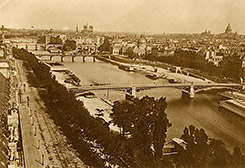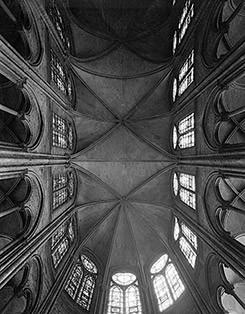Before the Fire: Notre-Dame de Paris in Pictures
Immortalized in art and literature, the Cathedral of Notre-Dame de Paris is the enduring symbol of the city of Paris. It is no surprise, then, that so many people around the world—some who may have never visited it—feel the loss caused by the catastrophic fire of April 15, 2019.
To help mitigate the shock of the images of the fire’s destruction, the department of image collections of the National Gallery of Art Library has selected a variety of photographs documenting the building and its place in the Parisian landscape. These images range in date from 1852 (a salt print by Henri Le Secq, from the early days of the invention of photography) to the modern era, including a selection from the documentary campaign of scholar Clarence Ward and his photographer, Arthur Princehorn, from the late 1920s to early 1930s. Many early French photographic firms are known today only by their initials, “A. G.” or “X” as examples.
Click on a slide above to view a larger image and detailed description (39 images total)
In 1160, the Romanesque cathedral that stood on the site was demolished so that a new Gothic structure could be built reusing many of the same stones. Construction began in 1163 with King Louis VII and Pope Alexander III presiding at the laying of the cornerstone. The choir and ambulatories at the east end were completed in 1177 and the high altar was consecrated in 1182. The second wave of construction commenced in 1182; work on the nave, west facade, and the shallow bays serving as transepts was largely completed by 1250. In the 13th century, through the use of flying buttresses, the walls of the nave and choir were raised higher and made thinner so they could be punctuated with brilliantly colored stained-glass windows. Construction on the cathedral was completed in 1345.
Notre-Dame survived various uprisings and wars over the centuries, including the French Revolution, although sculptures decorating the façade were vandalized. By the early decades of the 19th century, the edifice was in poor condition and restoration was authorized by King Louis-Philippe. The commission was awarded to Eugène Viollet-le-Duc and Jean-Baptiste Lassus, who restored and recreated Notre-Dame in a more romantic Gothic ideal popular in the 19th century. One of their most notable additions was a new spire, one that was taller and enhanced with figures of the apostles and evangelists, to replace the old one removed in the 18th century. They also added many of the gargoyles that are so popular with viewers today.
The fire on April 15 destroyed much of the roof of the cathedral and the spire. The exterior walls, towers, buttresses, pipe organ, and stained glass seem to have survived unscathed, but the exact condition of these elements is still being assessed as the building is stabilized. A significant portion of the artworks and decorations inside the church was also rescued, but a list of lost works has not yet been assembled. Plans for rebuilding Notre-Dame have already begun in the hope that a new spire will one day rise as a symbol of the renewed cathedral.
The library is open Monday through Friday 11:00 a.m. to 4:30 p.m. We are closed Saturday, Sunday, and federal holidays.
To help us prepare materials ahead of your initial visit, we recommend you request an appointment.
Location
National Gallery of Art East Building
4th Street and Pennsylvania Avenue NW
Washington, DC
Mailing Address
Image Collections
National Gallery of Art
2000 South Club Drive
Landover, MD 20785
Contact [email protected] or call (202) 842-6026







































